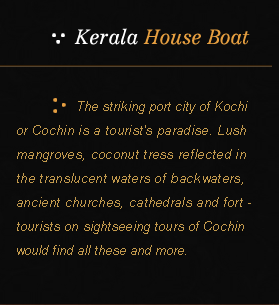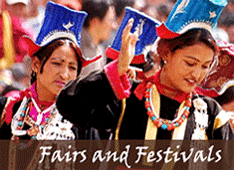Home > Luxury Holiday Series > Wildlife Trails of India

Duration : 20 Days & 19 Nights
Location : Delhi – Jaipur – Alwar – Agra – Panna – Bandhavgarh – Kanha – Pench – Delhi.
Location : Delhi – Jaipur – Alwar – Agra – Panna – Bandhavgarh – Kanha – Pench – Delhi.
Day 01
Delhi Arrival:
COMPANY REPRESENTATIVE will receive you on arrival at the DELHI AIRPORT and transfer to your hotel.
DELHI, the capital of kingdoms and empires is now a sprawling metropolis with a fascinating blend of the past and the present. It is a perfect introduction to the composite culture of an ancient land. A window to the kaleidoscope - that is India.
Overnight will be at Delhi.
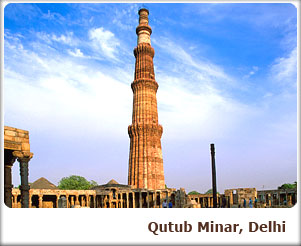 Day 02
Day 02
Delhi:
After breakfast proceed for a day sightseeing tour of the city.
The city is dotted with historic monuments that are the most popular tourist attractions in Delhi. Apart from the monuments, there are museums, markets, gardens and eating joints that you can visit on your tour of Delhi. Some of the important sightseeing places in Delhi are given below.
INDIA GATE: It is the war memorial dedicated to Indian soldiers, who died during World War I. The name of many soldiers who died during World War I is inscribed on its wall. Edward Lutyens, the man who planned and built New Delhi, designed India Gate. Almost every foreign tourist visits the monument. 'Amar Jawan Jyoti', the eternal flame is added later. The eternal flame runs on gas and is a tribute to soldiers who lost their lives in the service of the nation.
RED FORT: Located in Old Delhi, the Red Fort or Lal Quila is a popular tourist attraction in Delhi. The fort was built by the Mughal emperor Shah Jahan in 1648, when he moved his capital from Agra to Delhi. The construction of the Fort started in 1638 and it was completed 10 years later in 1648. Some of the important spots inside the Red Fort include royal baths or Shahi hamams, Shahi Burj, Moti Masjid or the Pearl Mosque, Diwan-e-Aam and Diwan-e-Khas.
JAMA MASJID: The largest mosque in India, the Jama Masjid was built by Shah Jahan 1656 AD. About 5,000 laborers and craftsmen worked for six years to complete the monument. The mosque can accommodate about 25,000 people. The mosque is located in the old Delhi. The domes are built in white marble. The prayer hall of the mosque has 260 pillars.
OLD FORT: Old Fort or Purana Quila as it is called is located near Pragati Maidan on the Mathura Road. You can club a visit to the Old Fort with your tour of Red Fort and Jama Masjid as the three monuments are located in Old Delhi and are not too far from one another. Humanyun’s started the construction of the fort in 1533 AD, but before the completion of the fort, Sher Shah Suri defeated him and captured Delhi. Sher Shah Suri completed the fort and named it -Shergah. He added many structures to the fort, of which Qila-I-Kuhna Mosque and Sher Mandal are worth mentioning. In 1555, Humanyun’s re-captured Delhi and converted Sher Mandal into a library.
HUMANYUN’S TOMB: Humanyun’s Tomb is mausoleum of the Mughal emperor Humanyun’s. Bega Begum also known as Haji Begum, wife of Humanyun’s constructed the mausoleum for her husband. The tomb was built between 1562 and 1572 AD. The tomb was designed by Mirak Mirza Ghiyuth.
QUTAB MINAR: The construction of the Qutab Minar was stated by Qutub-ud-din Aibak in 1199 AD but he died before completing it. His son-in-law and successor Iltutmish completed the construction of the building. Qutab Minar is located in Meharauli.
LOTUS TEMPLE: Also known as the Bahai Temple, the monument was opened to public only in 1986. Located near Nehru Place, the Lotus Temple is designed like a lotus flower. If you are looking for some moments of peace and tranquility in the crowded city, Lotus Temple is the ideal place to visit.
Apart from the above-mentioned sightseeing options, there are various other tourist attractions that you can visit on your tour of Delhi. Some other sightseeing places in Delhi include Lodi Gardens, National Museum, Jantar Mantar, Dilli Haat and the Garden of Five Senses.
Overnight will be at Delhi.
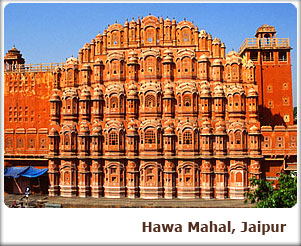 Day 03
Day 03
Delhi – Jaipur:
By Road 260Kms/05hrs
Drive to Jaipur after leisurely breakfast.
Jaipur is the capital of the state of Rajasthan a romantic realm of resplendent palaces, mighty fortresses and regal Maharajahs that lies in the western deserts and is an utterly unique part of India. Proudly belonging to the KSHATRIYA warrior caste and fiercely independent, the Rajput princes made fearsome foes. However, many of them realized that to maintain their wealth and authority locally, it was expedient to proclaim allegiance to the central power. Thus, many enjoyed a privileged position under the Mughal emperors and also the British Raj that followed.
The bustling Rajasthan capital of Jaipur takes its name from its venerated founder Jai Singh II, who was given the title Sawai Maharaja by the Mughal. Literally translated this would mean ’one and a quarter’, suggesting that the Mughal thought this emperor to be more valuable than just ‘one’. Jaipur is known as the ’Pink City’ on account of the distinctive colour of its buildings. This did not, however, form part of the original plan, but dates back to 1856, when the city was given a wash of pink in honor of a State Visit from Prince Albert.
This evening, visit the Birla Temple to learn more about the fascinating religious life of Jaipur. The marble structure, built as recently as 1985, houses ornate statues including one of Lakshmi (goddess of Wealth and Beauty) and Narayan dressed in gaudy robes, representing a Hindu vision of heavenly luxury. Carvings in the temple and on pillars supporting the covered walkways include images of the Hindu pantheon, as well as Jesus, the Blessed Virgin Mary and St Francis of Assisi. Your visit will coincide with the AARTI Ceremony, which involves oil lamps being lit and waved, in order to awake and invoke the deity.
Enjoy the experience and spend night at Jaipur.
Day 04
Jaipur:
After breakfast drive to Amber Palace. Enjoy Elephant Back ascent to the Fort.
AMER PALACE & FORT: Amer Fort and Palace was originally built by Raja Man Singh and subsequently developed by Sawai Jai Singh. The major attractions are Sheela Devi Temple, Sheesh Mahal (Hall of mirrors), Jai Garh Fort a few kilometers from the city centre was built for the defence of the town and has one of the world’s biggest cannons on wheels and a rich collection of arms and weapons.
Continue city sightseeing.
HAWA MAHAL (PALACE OF WINDS): Hawa Mahal is the most strikingly designed monument in Jaipur. Built by the Poet-King Sawai Pratap Singh in 1799, the Hawa Mahal is centrally located and is multiniched five storey high back view of the compled. It was conceived to provide an adequate vantage position behind delicate stone-carved jali, screens for the palace women to watch the royal processions passing through the Bazar below without being seen by outsiders. The Top of the palace affords a beautiful view of the city. A small archaeological museum is yet another attraction in the palace.
JAL MAHAL: The Jal Mahal Palace, Jaipur is noted for its intricate architecture. The Palace was developed as a pleasure spot. It was used for the royal duck shooting parties. On the road to Amber at a distance of 6.5 Kms from Jaipur are the cenotaphs of the royal family. A causeway leads to Jal Mahal Palace situated in the middle of Man Sagar Lake, opposite the cenotaphs. The first four floors of this building are under water; only the top floor remains outside. One can have a wonderful view of the lake and the palace from Nahar Garh Fort Built in 1799, the palace is now abandoned, but reasonably well preserved. In the monsoons, it looks particularly startling with its red sandstone set against the water hyacinth filled lake.
THE CITY PALACE: The city Palace is a historic landmark. The Carved arches are supported by grey-white marble columns studded with floral motifs in gold and colored stones. Two elephants carved in marble, guard the entrance, where retainers whose families have served generations of the rulers are at hand, to serve as guides.
JANTAR MANTAR: Jantar Mantar is one of Sawai Jai Singh’s five remarkable observatories. Constructed with stone and marble its compled instruments, whose setting and shapes are precisely and scientifically designed, represent the high-points of medieval Indian Astronomy. The two Ram Yantras used for gauging altitudes are unique in their isolation. This is the largest of five observatories founded by Sawai Jai Singh-II in various parts of the country.
This evening is free for you to relax shop or explore independently. Shopping is superb in Jaipur, particularly for gold and silver jewellery, pottery, tie-dye materials, silk, saris, wooden handicrafts and carpets.
Overnight will be at Jaipur.
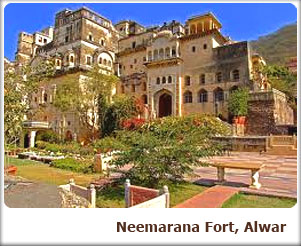 Day 05
Day 05
Jaipur – Alwar:
BY Road 45Kms/01hr
Breakfast will be at the hotel.
Drive to Alwar. Reach and check into the resort and let the professionals plan your next couple of days in the lap of nature and luxury.
Derived from the Sanskrit word for peace “AMAN” , and “BAGH” or garden in Hindi, AMANBAGH is a verdant oasis of mature palm, fruit and eucalyptus trees lying within a walled compound once the staging area for royal units. Evoking the palatial grandeur of the MOGHUL era, the 24 suites and 16 pool pavilions provide a tranquil garden from which to access the rich heritage of Rajasthan’s dramatic frontier region.
Enjoy a night excursion to the fort.
Overnight will be at the resort.
Day 06
Alwar:
Breakfast will be at the hotel.
Spend day at relaxation visiting the local village and the markets or taking an excursion the forests beyond.
Overnight will be at AMANBAGH.
Day 07
Alwar – Fatehpur Sikri – Agra:
By Road 175Kms/04hrs
Breakfast will be at the hotel.
Proceed to Agra visiting Fatehpur Sikri enroute.
FATEHPUR SIKRI – THE CITY OF VICTORY: 37 Kms from the city of Agra, stands Fatehpur Sikri, Akbar’s capital. Full credit goes to the Archeological Survey of India for this perfectly preserved example of a Mughal city at the height of the empire’s splendor. It is an attraction no visitor to Agra should miss. This sprawling structure is made of red sandstone and combines both Hindu and Mughal architecture. This walled city contains the mausoleum of the Sufi fakir, Saleem Chisti who is said to have granted Akbar and his Hindu queen Jodhabai their wish for a son. The main entrance to Fatehpur Sikri is through the 175 feet Buland Darwaza, the highest gateway in the world. It was built by Akbar to commemorate his victory over Khandesh in Gujarat. The Panch Mahal is a five-storeyed tower, the highest point in Fatehpur Sikri. This extremely airy tower is supposed to have been used by one of the emperor's many queens.
Continue drive to Agra. Reach and check into the hotel.
AGRA: Two great Mughal monarchs, Akbar and Shah Jahan, transformed the little village of Agra into a befitting second capital of the Mughal Empire – giving it the name Dar-ul-Khilafat {seat of the Emperor}. Today a visitor to Agra is caught up in a world of contrasting edifices, of red sandstone and white marble, narrow galleys and quaint buggies, and that irresistible charm that this favorite city of the Mughals still retains. It is not surprising, that modern Agra still reflects its Mughal heritage most conspicuously. A walk down the narrow bustling streets of the city will introduce the visitor to the wafting aroma of Mughlai cuisine.
Overnight will be at Agra.
Day 08
Agra:
Enjoy breakfast at the hotel.
Proceed for day sightseeing of Agra.
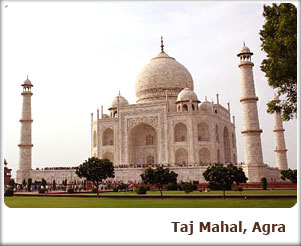 THE TAJ MAHAL – AN EMPEROR’S LAMENT: Agra is the city of the Taj Mahal. It is a sublime experience of the greatest love story ever told. Today India's most fascinating and beautiful masterpiece, this perfectly symmetrical edifice is set amidst landscaped gardens on the banks of the Yamuna River. The Taj was built by the Mughal Emperor Shahjahan as a memorial to his wife, Mumtaz Mahal. After her untimely death, Shah Jahan had her mortal remains buried in this mausoleum. And after his own demise he was placed to rest next to his beloved queen in the same mausoleum. Under the dome, below the ground level, in a dimly lit chamber, lie the mortal remains of Shahjahan and his beloved queen Mumtaz, reminding the world of their undying love. The Taj remains closed for visitors on Friday
THE TAJ MAHAL – AN EMPEROR’S LAMENT: Agra is the city of the Taj Mahal. It is a sublime experience of the greatest love story ever told. Today India's most fascinating and beautiful masterpiece, this perfectly symmetrical edifice is set amidst landscaped gardens on the banks of the Yamuna River. The Taj was built by the Mughal Emperor Shahjahan as a memorial to his wife, Mumtaz Mahal. After her untimely death, Shah Jahan had her mortal remains buried in this mausoleum. And after his own demise he was placed to rest next to his beloved queen in the same mausoleum. Under the dome, below the ground level, in a dimly lit chamber, lie the mortal remains of Shahjahan and his beloved queen Mumtaz, reminding the world of their undying love. The Taj remains closed for visitors on Friday
AGRA FORT – ARCHITECTURAL WONDER IN STONE: Within a radius of 3 kilometers, on the banks of the river Yamuna raises the crescent like Agra Fort. Designed and built by Akbar in 1565 A.D., the fort is surrounded by a 70 feet high wall. It houses the beautiful Pearl Mosque and numerous palaces including the Jahangir Mahal, Diwan-i-Khas, Diwan-i-Am and Moti Masjid. Later it was used by his son Jahangir also as the seat of power. Shahjahan modeled his creation, the Red Fort at Delhi on this fort. The Agra fort happens to be on the same bank of the river Yamuna as the Taj Mahal which is visible in all its beauty from one side of the fort. So very ironically, Shahjahan, a prisoner of his son Aurangzeb in his old age was put in a cell from where he could gaze at the Taj Mahal at a distance, from his cell in the Agra Fort.
The fort has four gates and is enclosed by a double barricaded wall of red sand stone. Many buildings were constructed within the fort of which very few remain till date. One of the most significant ones is the multi storied Jahangir Mahal built by Akbar for his wife Jodha Bai. The Mahal is reached through an impressive gateway and its inner courtyard consists of beautiful halls, profuse carvings on stone, exquisitely carved heavy brackets, piers and cross beams.
ITMAD – UL – DAULAH’A TOMB: This tomb was erected by Nur Jahan in sweet memory of her father Ghiasud-Din-Beg between 1622 - 1628 A.D. This white marble structure of the pre-Taj era though smaller is often considered equal if not better to the great one itself.
Overnight will be at Agra.
Day 09
Agra – Jhansi:
By Deluxe Train
Jhansi – Orchha – Panna:
By Road 180Kms/05hrs
Early morning transfer to the railway station to board train for Jhansi. Reach Jhansi and drive to Panna visiting Orchha enroute.
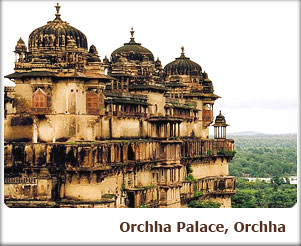 ORCHHA - The grandeur and opulence of the former Bundela dynasty is well reflected in Orchha set amidst the flat Bundelkhand countryside. Built by Raja Rudra Pratap on an artificial island on Betwa river, Orchha (17 Km from Jhansi) takes you back to a royal era when Bundela rulers enjoyed the finer things of life cocooned in the comforts of their citadel. Orchha is a photographer's delight. With its forts, regal palaces, striking temples and chattris, it narrates a beautiful medieval tale.
ORCHHA - The grandeur and opulence of the former Bundela dynasty is well reflected in Orchha set amidst the flat Bundelkhand countryside. Built by Raja Rudra Pratap on an artificial island on Betwa river, Orchha (17 Km from Jhansi) takes you back to a royal era when Bundela rulers enjoyed the finer things of life cocooned in the comforts of their citadel. Orchha is a photographer's delight. With its forts, regal palaces, striking temples and chattris, it narrates a beautiful medieval tale.
After lunch continue drive to Panna. Reach and check into the hotel.
Sheltered in Madhya Pradesh, Panna National Park is at a distance of around 57 km from the nearby temple-town of Khajuraho. Panna city is especially famous for its diamond industry. Nevertheless, what adds to the popularity of the place is Panna Wildlife Sanctuary, which is also a renowned Tiger Reserve of India. The place sees major tourist footfalls due to its distinctive mark, as far as its wildlife variety is concerned. Moreover, tourists visiting Khajuraho also love to take a quick day out to this park. You can easily reach the Panna National Park by air or road from Khajuraho (57 km). By train, the most convenient railhead is Satna, located at a distance of 90 km from Panna.
Flora: As the climatic condition in this area mostly remains arid and hot, teak and dry mixed forest is what comprises the flora of Panna National Park. The total area of the place stretches to about 543 sq km and is a miscellany of dry deciduous forest, along with patches of prairies. Thorny woodlands and riverines also remain scattered amidst the blossoming vegetation. Trees like common teak, tendu, mahua and dhaora can be included among the wide varieties of floral species that form a major feature of the park.
Fauna: The animal wealth of Panna National Park is globally recognized. Animals like tigers, wild cats, deer and antelopes are some of the major species that the park boasts of. In fact, you can often spot tigers taking lazy strolls in the forested lands of the park. Leopards, wild dogs, wolves, hyenas, caracals are also frequent sights. The groves are speckled with animals like sambar and Chausingha. Sleepy dales cuddle many sloth bears and animals like Nilgai and chinkara dot the open prairies. Reptiles are also another major attraction of this park.
Avifauna: You can witness a wide variety of avifauna, as the park houses more than 200 species of birds. It also shelters many migratory birds. White-necked stork, honey buzzard, king vulture, bareheaded goose, blossom headed parakeet, paradise flycatcher, slaty-headed scimitar, babbler are some of the many exciting and colorful birds that comprises the avifauna of the park.
Overnight will be at Panna.
Day 10
Panna:
Breakfast will be at the hotel.
Proceed for full day game viewing inside the jungle. (Two safaris with lunch break in-between).
Overnight will be at Panna.
Day 11
Panna – Bandhavgarh:
By Road 200Kms/06hrs
Breakfast will be at the hotel.
Drive to Bandhavgarh. Reach and check into the hotel.
Bandhavgarh National Park is located in Umaria district on the extreme north- eastern border of Madhya Pradesh. Although Bandhavgarh is a small forest reserve, in the last few years, it has become one of the most prominent National Parks, owing to the high density of its tiger population. The mixed forests of Sal and bamboo and the abundance of water and prey create a very conducive atmosphere for the tiger population here. Bandhavgarh was declared a National Park in 1968 with an area of 105 sq. kilometers. The park is open from October to June every year and closed during the monsoons. There are three ways of exploring the forest here: vans, open jeeps or on elephants back. Apart from tigers you can also see sambar, chital, chinkara, barking deer, wild boar, leopard, and sloth bears.
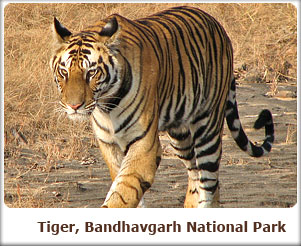 The Park is spread over an area of 437 sq. km. The terrain is made of rocky hills, sal forests and grazing areas, formerly agricultural land. The finest of these hills is the Bandhavgarh hill, and on its highest point stands Bandhavgarh Fort. Though no records remain to show when the fort was constructed, it is believed to be about 2000 years old. Several dynasties have ruled the fort: for example, the Maghas from the 1st century A.D, the Vakatakas from the 3rd century; the Sengars from the 5th century, and the Kalachuris from the 10th century. The oldest signs of habitation are the caves dug into the sandstone, near the fort. Several of these contain Brahmi inscriptions dating from the 1st century B.C. Prior to becoming a National Park, the forest range around the region had been maintained as a Shikargarh, or game preserve, of the Maharajahs of Rewa. It was only in 1968, that the area was declared as a National Park. Since then, stringent steps have been taken to retain it as an unspoilt natural habitat. The fort now is the private property of the Maharaja of Rewa and prior permission is required to visit it. A one hour trek leads up to the fort and the track is dotted by the small temples of the 12th century, unspoiled forests, and small meandering streams.
The Park is spread over an area of 437 sq. km. The terrain is made of rocky hills, sal forests and grazing areas, formerly agricultural land. The finest of these hills is the Bandhavgarh hill, and on its highest point stands Bandhavgarh Fort. Though no records remain to show when the fort was constructed, it is believed to be about 2000 years old. Several dynasties have ruled the fort: for example, the Maghas from the 1st century A.D, the Vakatakas from the 3rd century; the Sengars from the 5th century, and the Kalachuris from the 10th century. The oldest signs of habitation are the caves dug into the sandstone, near the fort. Several of these contain Brahmi inscriptions dating from the 1st century B.C. Prior to becoming a National Park, the forest range around the region had been maintained as a Shikargarh, or game preserve, of the Maharajahs of Rewa. It was only in 1968, that the area was declared as a National Park. Since then, stringent steps have been taken to retain it as an unspoilt natural habitat. The fort now is the private property of the Maharaja of Rewa and prior permission is required to visit it. A one hour trek leads up to the fort and the track is dotted by the small temples of the 12th century, unspoiled forests, and small meandering streams.
There are more than 22 species of mammals, and 250 species of birds. Some of the inhabitants of this park are the rhesus macaque, the black-faced langur, jungle cats, chinkara, black buck, munjtac and the chital. The Park attracts many migratory birds in the winter months that include the steppe eagle and a variety of wildfowl. Reptilian fauna include cobra, krait, python, turtle and a variety of lizards. The Bandhavgarh National Park has excellent game and bird viewing to offer, coupled with a fascinating historical element to it, thus satiating those adventurous at heart, completely.
The park can be explored on elephant back (also, a much preferred means of tiger-tracking) or in a vehicle. Jeep safaris are best undertaken, from dawn till about 10a.m, and from 4 p.m till dusk, as the animals are quite active during these periods.
Overnight will be at Bandhavgarh.
Day 12
Bandhavgarh:
Breakfast will be at the hotel.
Proceed for full day game viewing inside the jungle. (Two safaris with lunch break in-between).
Visit Bandhavgarh Fort.
Overnight will be at Bandhavgarh.
Day 13
Bandhavgarh:
Breakfast will be at the hotel.
Proceed for full day game viewing inside the jungle. (Two safaris with lunch break in-between).
Overnight will be at Bandhavgarh.
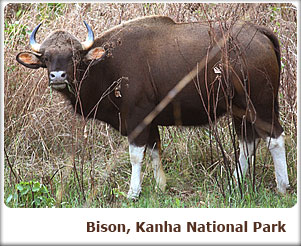 Day 14
Day 14
Bandhavgarh – Kanha:
By Road 255Kms/06hrs
Breakfast will be at the hotel.
Drive to Kanha. Reach and check into the hotel.
A land that inspired Rudyard Kipling to write his classic novel 'Jungle Book', the forested areas of Kanha, with their wild thickets of sal and bamboo forests, rolling meadows and dramatic ravines, are home to the Kanha National Park. The Created in 1955, the national park is today the core area of the Kanha Tiger Reserve, which came into being in 1974, under Project Tiger. The Banjar and the Halon valley form the two halves constituting the vast stretches of land that is the Kanha Tiger Reserve.
One of the greatest achievements of this park is perhaps its contribution in saving many endangered wildlife species, which nearly bordered extinction. The park today steadfastly guards the different genus of wildlife it domiciles and follows painstaking measures to maintain the overall protection of its flora, fauna and avifauna. The popular 'Sunset Point' or 'Bamni Dadar' inside the park is the best lookout point that allows visitors to soak the beautiful landscape of the park and relish rare sights of wildlife viewing.
Wildlife: Trailing a wild tiger lazing around the shades of the forests of Kanha offers its own charm. In fact, the tigers remain the most exciting draw of the place. The park is also home to Sambars and Gaurs, which are generally seen in the green meadows, grazing away the grasses to glory. Animals like blackbuck and chital are also common sights. Other main wildlife attractions of the park include bison, barasingha, barking deer, black deer, chousingha, nilgai, mouse deer, sloth bear, jackal fox, porcupine, hyena, jungle cat, python, mongoose, and leopard.
Avifauna: Apart from the many species of animals that contribute to the wealth of fauna of this jungled beauty, one can also notice a wide variety of exotic birds here. Avifauna of the park include bird species like storks, peacocks, teals, pintails, pond herons, egrets, pea fowl, jungle fowl, spur fowl, papihas, partridges, ring doves, quails, spotted parakeets, green pigeons, rock pigeons, cuckoos, rollers, bee-eater, hoopoes, drongos, warblers, kingfishers, woodpeckers, finches, orioles, owls, and fly catchers. Thus, the place is indeed an ornithological wonder and a paradise for all bird watchers.
Overnight will be at Kanha.
Day 15
Kanha:
Breakfast will be at the hotel.
Proceed for full day game viewing inside the jungle. (Two safaris with lunch break in-between).
Overnight will be at Kanha.
Day 16
Kanha:
Breakfast will be at the hotel.
Proceed for full day game viewing inside the jungle. (Two safaris with lunch break in-between).
Overnight will be at Kanha.
Day 17
Kanha - Pench:
By Road 250Kms/06hrs
Breakfast will be at the hotel.
Drive to Pench. Reach and check into the hotel.
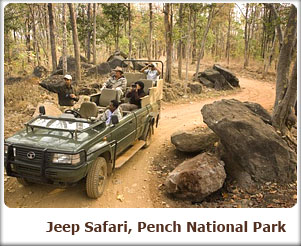 Pench National Park falls under the Seoni and Chhindwara districts of Madhya Pradesh. It derives its name from the Pench River that flows through its heart and divides it into two, equal western and eastern halves - Chhindwara and Seoni respectively. Declared as a wildlife sanctuary in 1977, eventually the place got elevated to the status of a National Park in 1983. Later, its eminence led to its incorporation under the umbrella of 'Project Tiger', as the 19th Project Tiger Reserve, in 1992. Sited on the southern fringes of Madhya Pradesh, the park covers a total area of 757.89 sq. km. Jabalpur and Nagpur serve as convenient airheads and railheads for reaching the park.
Pench National Park falls under the Seoni and Chhindwara districts of Madhya Pradesh. It derives its name from the Pench River that flows through its heart and divides it into two, equal western and eastern halves - Chhindwara and Seoni respectively. Declared as a wildlife sanctuary in 1977, eventually the place got elevated to the status of a National Park in 1983. Later, its eminence led to its incorporation under the umbrella of 'Project Tiger', as the 19th Project Tiger Reserve, in 1992. Sited on the southern fringes of Madhya Pradesh, the park covers a total area of 757.89 sq. km. Jabalpur and Nagpur serve as convenient airheads and railheads for reaching the park.
Landscape and Flora: The flora of Pench Tiger Reserve comprises mainly of Southern Indian tropical moist deciduous forest and tropical dry deciduous teak. Water bodies are found in the form of streams and 'nallahs'. Most of them are seasonal and meander in full zest during the monsoons. Pench River, which serves as the major water source, desiccates or dries up in April end. Then, water pools known as 'dohs' serve as water suppliers for the fauna of the park, along with Pench Reservoir. Teak is abundant and bamboos are sparse, and restricted to the valleys. White kuku trees are very common and stand out prominently amidst the greenery.
Fauna and Avifauna: Tigers are usually seen around the Pench River, as the density of prey population is higher here. There are 25 tigers recorded in this park. It is also the jungle abode of 39 species of mammals, 13 species of reptiles, 3 species of amphibians and over 170 varieties of birds. Major species of fauna include leopards, cheetal, sambar, Nilgai, jackals, wild dogs, gaur, sloth bears, langoors, small Indian civets and palm civets. There are also more than 210 species of birds, including a host of migratory species. The most common birds are peafowl, crow pheasant, crimson breasted barbet, red vented bulbul, red jungle fowl, racket tailed drongo, magpie robin and whistling teal.
Overnight will be at Pench
Day 18
Pench:
Breakfast will be at the hotel.
Proceed for full day game viewing inside the jungle. (Two safaris with lunch break in-between).
Overnight will be at Pench.
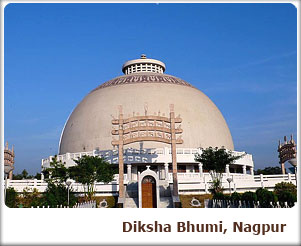 Day 19
Day 19
Pench - Nagpur:
By Road 95Kms/02hrs
Nagpur – Delhi:
By Air
Enjoy morning safari.
Breakfast will be at the hotel.
Drive to Nagpur airport to take flight for Delhi. Reach Delhi and check into the hotel.
Overnight will be at Delhi.
Day 20
Delhi – Departure:
Morning enjoy the breakfast.
As per your INTERNATIONAL FLIGHT TIMINGS you’ll be transferred to the airport to take your flight back home with sweet memories of SAFARI TOUR.
...........................................................................TOUR ENDS...........................................................................
INCLUSIONS:
EXCLUSIONS:
Delhi Arrival:
COMPANY REPRESENTATIVE will receive you on arrival at the DELHI AIRPORT and transfer to your hotel.
DELHI, the capital of kingdoms and empires is now a sprawling metropolis with a fascinating blend of the past and the present. It is a perfect introduction to the composite culture of an ancient land. A window to the kaleidoscope - that is India.
Overnight will be at Delhi.
 Day 02
Day 02 Delhi:
After breakfast proceed for a day sightseeing tour of the city.
The city is dotted with historic monuments that are the most popular tourist attractions in Delhi. Apart from the monuments, there are museums, markets, gardens and eating joints that you can visit on your tour of Delhi. Some of the important sightseeing places in Delhi are given below.
INDIA GATE: It is the war memorial dedicated to Indian soldiers, who died during World War I. The name of many soldiers who died during World War I is inscribed on its wall. Edward Lutyens, the man who planned and built New Delhi, designed India Gate. Almost every foreign tourist visits the monument. 'Amar Jawan Jyoti', the eternal flame is added later. The eternal flame runs on gas and is a tribute to soldiers who lost their lives in the service of the nation.
RED FORT: Located in Old Delhi, the Red Fort or Lal Quila is a popular tourist attraction in Delhi. The fort was built by the Mughal emperor Shah Jahan in 1648, when he moved his capital from Agra to Delhi. The construction of the Fort started in 1638 and it was completed 10 years later in 1648. Some of the important spots inside the Red Fort include royal baths or Shahi hamams, Shahi Burj, Moti Masjid or the Pearl Mosque, Diwan-e-Aam and Diwan-e-Khas.
JAMA MASJID: The largest mosque in India, the Jama Masjid was built by Shah Jahan 1656 AD. About 5,000 laborers and craftsmen worked for six years to complete the monument. The mosque can accommodate about 25,000 people. The mosque is located in the old Delhi. The domes are built in white marble. The prayer hall of the mosque has 260 pillars.
OLD FORT: Old Fort or Purana Quila as it is called is located near Pragati Maidan on the Mathura Road. You can club a visit to the Old Fort with your tour of Red Fort and Jama Masjid as the three monuments are located in Old Delhi and are not too far from one another. Humanyun’s started the construction of the fort in 1533 AD, but before the completion of the fort, Sher Shah Suri defeated him and captured Delhi. Sher Shah Suri completed the fort and named it -Shergah. He added many structures to the fort, of which Qila-I-Kuhna Mosque and Sher Mandal are worth mentioning. In 1555, Humanyun’s re-captured Delhi and converted Sher Mandal into a library.
HUMANYUN’S TOMB: Humanyun’s Tomb is mausoleum of the Mughal emperor Humanyun’s. Bega Begum also known as Haji Begum, wife of Humanyun’s constructed the mausoleum for her husband. The tomb was built between 1562 and 1572 AD. The tomb was designed by Mirak Mirza Ghiyuth.
QUTAB MINAR: The construction of the Qutab Minar was stated by Qutub-ud-din Aibak in 1199 AD but he died before completing it. His son-in-law and successor Iltutmish completed the construction of the building. Qutab Minar is located in Meharauli.
LOTUS TEMPLE: Also known as the Bahai Temple, the monument was opened to public only in 1986. Located near Nehru Place, the Lotus Temple is designed like a lotus flower. If you are looking for some moments of peace and tranquility in the crowded city, Lotus Temple is the ideal place to visit.
Apart from the above-mentioned sightseeing options, there are various other tourist attractions that you can visit on your tour of Delhi. Some other sightseeing places in Delhi include Lodi Gardens, National Museum, Jantar Mantar, Dilli Haat and the Garden of Five Senses.
Overnight will be at Delhi.
 Day 03
Day 03 Delhi – Jaipur:
By Road 260Kms/05hrs
Drive to Jaipur after leisurely breakfast.
Jaipur is the capital of the state of Rajasthan a romantic realm of resplendent palaces, mighty fortresses and regal Maharajahs that lies in the western deserts and is an utterly unique part of India. Proudly belonging to the KSHATRIYA warrior caste and fiercely independent, the Rajput princes made fearsome foes. However, many of them realized that to maintain their wealth and authority locally, it was expedient to proclaim allegiance to the central power. Thus, many enjoyed a privileged position under the Mughal emperors and also the British Raj that followed.
The bustling Rajasthan capital of Jaipur takes its name from its venerated founder Jai Singh II, who was given the title Sawai Maharaja by the Mughal. Literally translated this would mean ’one and a quarter’, suggesting that the Mughal thought this emperor to be more valuable than just ‘one’. Jaipur is known as the ’Pink City’ on account of the distinctive colour of its buildings. This did not, however, form part of the original plan, but dates back to 1856, when the city was given a wash of pink in honor of a State Visit from Prince Albert.
This evening, visit the Birla Temple to learn more about the fascinating religious life of Jaipur. The marble structure, built as recently as 1985, houses ornate statues including one of Lakshmi (goddess of Wealth and Beauty) and Narayan dressed in gaudy robes, representing a Hindu vision of heavenly luxury. Carvings in the temple and on pillars supporting the covered walkways include images of the Hindu pantheon, as well as Jesus, the Blessed Virgin Mary and St Francis of Assisi. Your visit will coincide with the AARTI Ceremony, which involves oil lamps being lit and waved, in order to awake and invoke the deity.
Enjoy the experience and spend night at Jaipur.
Day 04
Jaipur:
After breakfast drive to Amber Palace. Enjoy Elephant Back ascent to the Fort.
AMER PALACE & FORT: Amer Fort and Palace was originally built by Raja Man Singh and subsequently developed by Sawai Jai Singh. The major attractions are Sheela Devi Temple, Sheesh Mahal (Hall of mirrors), Jai Garh Fort a few kilometers from the city centre was built for the defence of the town and has one of the world’s biggest cannons on wheels and a rich collection of arms and weapons.
Continue city sightseeing.
HAWA MAHAL (PALACE OF WINDS): Hawa Mahal is the most strikingly designed monument in Jaipur. Built by the Poet-King Sawai Pratap Singh in 1799, the Hawa Mahal is centrally located and is multiniched five storey high back view of the compled. It was conceived to provide an adequate vantage position behind delicate stone-carved jali, screens for the palace women to watch the royal processions passing through the Bazar below without being seen by outsiders. The Top of the palace affords a beautiful view of the city. A small archaeological museum is yet another attraction in the palace.
JAL MAHAL: The Jal Mahal Palace, Jaipur is noted for its intricate architecture. The Palace was developed as a pleasure spot. It was used for the royal duck shooting parties. On the road to Amber at a distance of 6.5 Kms from Jaipur are the cenotaphs of the royal family. A causeway leads to Jal Mahal Palace situated in the middle of Man Sagar Lake, opposite the cenotaphs. The first four floors of this building are under water; only the top floor remains outside. One can have a wonderful view of the lake and the palace from Nahar Garh Fort Built in 1799, the palace is now abandoned, but reasonably well preserved. In the monsoons, it looks particularly startling with its red sandstone set against the water hyacinth filled lake.
THE CITY PALACE: The city Palace is a historic landmark. The Carved arches are supported by grey-white marble columns studded with floral motifs in gold and colored stones. Two elephants carved in marble, guard the entrance, where retainers whose families have served generations of the rulers are at hand, to serve as guides.
JANTAR MANTAR: Jantar Mantar is one of Sawai Jai Singh’s five remarkable observatories. Constructed with stone and marble its compled instruments, whose setting and shapes are precisely and scientifically designed, represent the high-points of medieval Indian Astronomy. The two Ram Yantras used for gauging altitudes are unique in their isolation. This is the largest of five observatories founded by Sawai Jai Singh-II in various parts of the country.
This evening is free for you to relax shop or explore independently. Shopping is superb in Jaipur, particularly for gold and silver jewellery, pottery, tie-dye materials, silk, saris, wooden handicrafts and carpets.
Overnight will be at Jaipur.
 Day 05
Day 05 Jaipur – Alwar:
BY Road 45Kms/01hr
Breakfast will be at the hotel.
Drive to Alwar. Reach and check into the resort and let the professionals plan your next couple of days in the lap of nature and luxury.
Derived from the Sanskrit word for peace “AMAN” , and “BAGH” or garden in Hindi, AMANBAGH is a verdant oasis of mature palm, fruit and eucalyptus trees lying within a walled compound once the staging area for royal units. Evoking the palatial grandeur of the MOGHUL era, the 24 suites and 16 pool pavilions provide a tranquil garden from which to access the rich heritage of Rajasthan’s dramatic frontier region.
Enjoy a night excursion to the fort.
Overnight will be at the resort.
Day 06
Alwar:
Breakfast will be at the hotel.
Spend day at relaxation visiting the local village and the markets or taking an excursion the forests beyond.
Overnight will be at AMANBAGH.
Day 07
Alwar – Fatehpur Sikri – Agra:
By Road 175Kms/04hrs
Breakfast will be at the hotel.
Proceed to Agra visiting Fatehpur Sikri enroute.
FATEHPUR SIKRI – THE CITY OF VICTORY: 37 Kms from the city of Agra, stands Fatehpur Sikri, Akbar’s capital. Full credit goes to the Archeological Survey of India for this perfectly preserved example of a Mughal city at the height of the empire’s splendor. It is an attraction no visitor to Agra should miss. This sprawling structure is made of red sandstone and combines both Hindu and Mughal architecture. This walled city contains the mausoleum of the Sufi fakir, Saleem Chisti who is said to have granted Akbar and his Hindu queen Jodhabai their wish for a son. The main entrance to Fatehpur Sikri is through the 175 feet Buland Darwaza, the highest gateway in the world. It was built by Akbar to commemorate his victory over Khandesh in Gujarat. The Panch Mahal is a five-storeyed tower, the highest point in Fatehpur Sikri. This extremely airy tower is supposed to have been used by one of the emperor's many queens.
Continue drive to Agra. Reach and check into the hotel.
AGRA: Two great Mughal monarchs, Akbar and Shah Jahan, transformed the little village of Agra into a befitting second capital of the Mughal Empire – giving it the name Dar-ul-Khilafat {seat of the Emperor}. Today a visitor to Agra is caught up in a world of contrasting edifices, of red sandstone and white marble, narrow galleys and quaint buggies, and that irresistible charm that this favorite city of the Mughals still retains. It is not surprising, that modern Agra still reflects its Mughal heritage most conspicuously. A walk down the narrow bustling streets of the city will introduce the visitor to the wafting aroma of Mughlai cuisine.
Overnight will be at Agra.
Day 08
Agra:
Enjoy breakfast at the hotel.
Proceed for day sightseeing of Agra.
 THE TAJ MAHAL – AN EMPEROR’S LAMENT: Agra is the city of the Taj Mahal. It is a sublime experience of the greatest love story ever told. Today India's most fascinating and beautiful masterpiece, this perfectly symmetrical edifice is set amidst landscaped gardens on the banks of the Yamuna River. The Taj was built by the Mughal Emperor Shahjahan as a memorial to his wife, Mumtaz Mahal. After her untimely death, Shah Jahan had her mortal remains buried in this mausoleum. And after his own demise he was placed to rest next to his beloved queen in the same mausoleum. Under the dome, below the ground level, in a dimly lit chamber, lie the mortal remains of Shahjahan and his beloved queen Mumtaz, reminding the world of their undying love. The Taj remains closed for visitors on Friday
THE TAJ MAHAL – AN EMPEROR’S LAMENT: Agra is the city of the Taj Mahal. It is a sublime experience of the greatest love story ever told. Today India's most fascinating and beautiful masterpiece, this perfectly symmetrical edifice is set amidst landscaped gardens on the banks of the Yamuna River. The Taj was built by the Mughal Emperor Shahjahan as a memorial to his wife, Mumtaz Mahal. After her untimely death, Shah Jahan had her mortal remains buried in this mausoleum. And after his own demise he was placed to rest next to his beloved queen in the same mausoleum. Under the dome, below the ground level, in a dimly lit chamber, lie the mortal remains of Shahjahan and his beloved queen Mumtaz, reminding the world of their undying love. The Taj remains closed for visitors on FridayAGRA FORT – ARCHITECTURAL WONDER IN STONE: Within a radius of 3 kilometers, on the banks of the river Yamuna raises the crescent like Agra Fort. Designed and built by Akbar in 1565 A.D., the fort is surrounded by a 70 feet high wall. It houses the beautiful Pearl Mosque and numerous palaces including the Jahangir Mahal, Diwan-i-Khas, Diwan-i-Am and Moti Masjid. Later it was used by his son Jahangir also as the seat of power. Shahjahan modeled his creation, the Red Fort at Delhi on this fort. The Agra fort happens to be on the same bank of the river Yamuna as the Taj Mahal which is visible in all its beauty from one side of the fort. So very ironically, Shahjahan, a prisoner of his son Aurangzeb in his old age was put in a cell from where he could gaze at the Taj Mahal at a distance, from his cell in the Agra Fort.
The fort has four gates and is enclosed by a double barricaded wall of red sand stone. Many buildings were constructed within the fort of which very few remain till date. One of the most significant ones is the multi storied Jahangir Mahal built by Akbar for his wife Jodha Bai. The Mahal is reached through an impressive gateway and its inner courtyard consists of beautiful halls, profuse carvings on stone, exquisitely carved heavy brackets, piers and cross beams.
ITMAD – UL – DAULAH’A TOMB: This tomb was erected by Nur Jahan in sweet memory of her father Ghiasud-Din-Beg between 1622 - 1628 A.D. This white marble structure of the pre-Taj era though smaller is often considered equal if not better to the great one itself.
Overnight will be at Agra.
Day 09
Agra – Jhansi:
By Deluxe Train
Jhansi – Orchha – Panna:
By Road 180Kms/05hrs
Early morning transfer to the railway station to board train for Jhansi. Reach Jhansi and drive to Panna visiting Orchha enroute.
 ORCHHA - The grandeur and opulence of the former Bundela dynasty is well reflected in Orchha set amidst the flat Bundelkhand countryside. Built by Raja Rudra Pratap on an artificial island on Betwa river, Orchha (17 Km from Jhansi) takes you back to a royal era when Bundela rulers enjoyed the finer things of life cocooned in the comforts of their citadel. Orchha is a photographer's delight. With its forts, regal palaces, striking temples and chattris, it narrates a beautiful medieval tale.
ORCHHA - The grandeur and opulence of the former Bundela dynasty is well reflected in Orchha set amidst the flat Bundelkhand countryside. Built by Raja Rudra Pratap on an artificial island on Betwa river, Orchha (17 Km from Jhansi) takes you back to a royal era when Bundela rulers enjoyed the finer things of life cocooned in the comforts of their citadel. Orchha is a photographer's delight. With its forts, regal palaces, striking temples and chattris, it narrates a beautiful medieval tale. After lunch continue drive to Panna. Reach and check into the hotel.
Sheltered in Madhya Pradesh, Panna National Park is at a distance of around 57 km from the nearby temple-town of Khajuraho. Panna city is especially famous for its diamond industry. Nevertheless, what adds to the popularity of the place is Panna Wildlife Sanctuary, which is also a renowned Tiger Reserve of India. The place sees major tourist footfalls due to its distinctive mark, as far as its wildlife variety is concerned. Moreover, tourists visiting Khajuraho also love to take a quick day out to this park. You can easily reach the Panna National Park by air or road from Khajuraho (57 km). By train, the most convenient railhead is Satna, located at a distance of 90 km from Panna.
Flora: As the climatic condition in this area mostly remains arid and hot, teak and dry mixed forest is what comprises the flora of Panna National Park. The total area of the place stretches to about 543 sq km and is a miscellany of dry deciduous forest, along with patches of prairies. Thorny woodlands and riverines also remain scattered amidst the blossoming vegetation. Trees like common teak, tendu, mahua and dhaora can be included among the wide varieties of floral species that form a major feature of the park.
Fauna: The animal wealth of Panna National Park is globally recognized. Animals like tigers, wild cats, deer and antelopes are some of the major species that the park boasts of. In fact, you can often spot tigers taking lazy strolls in the forested lands of the park. Leopards, wild dogs, wolves, hyenas, caracals are also frequent sights. The groves are speckled with animals like sambar and Chausingha. Sleepy dales cuddle many sloth bears and animals like Nilgai and chinkara dot the open prairies. Reptiles are also another major attraction of this park.
Avifauna: You can witness a wide variety of avifauna, as the park houses more than 200 species of birds. It also shelters many migratory birds. White-necked stork, honey buzzard, king vulture, bareheaded goose, blossom headed parakeet, paradise flycatcher, slaty-headed scimitar, babbler are some of the many exciting and colorful birds that comprises the avifauna of the park.
Overnight will be at Panna.
Day 10
Panna:
Breakfast will be at the hotel.
Proceed for full day game viewing inside the jungle. (Two safaris with lunch break in-between).
Overnight will be at Panna.
Day 11
Panna – Bandhavgarh:
By Road 200Kms/06hrs
Breakfast will be at the hotel.
Drive to Bandhavgarh. Reach and check into the hotel.
Bandhavgarh National Park is located in Umaria district on the extreme north- eastern border of Madhya Pradesh. Although Bandhavgarh is a small forest reserve, in the last few years, it has become one of the most prominent National Parks, owing to the high density of its tiger population. The mixed forests of Sal and bamboo and the abundance of water and prey create a very conducive atmosphere for the tiger population here. Bandhavgarh was declared a National Park in 1968 with an area of 105 sq. kilometers. The park is open from October to June every year and closed during the monsoons. There are three ways of exploring the forest here: vans, open jeeps or on elephants back. Apart from tigers you can also see sambar, chital, chinkara, barking deer, wild boar, leopard, and sloth bears.
 The Park is spread over an area of 437 sq. km. The terrain is made of rocky hills, sal forests and grazing areas, formerly agricultural land. The finest of these hills is the Bandhavgarh hill, and on its highest point stands Bandhavgarh Fort. Though no records remain to show when the fort was constructed, it is believed to be about 2000 years old. Several dynasties have ruled the fort: for example, the Maghas from the 1st century A.D, the Vakatakas from the 3rd century; the Sengars from the 5th century, and the Kalachuris from the 10th century. The oldest signs of habitation are the caves dug into the sandstone, near the fort. Several of these contain Brahmi inscriptions dating from the 1st century B.C. Prior to becoming a National Park, the forest range around the region had been maintained as a Shikargarh, or game preserve, of the Maharajahs of Rewa. It was only in 1968, that the area was declared as a National Park. Since then, stringent steps have been taken to retain it as an unspoilt natural habitat. The fort now is the private property of the Maharaja of Rewa and prior permission is required to visit it. A one hour trek leads up to the fort and the track is dotted by the small temples of the 12th century, unspoiled forests, and small meandering streams.
The Park is spread over an area of 437 sq. km. The terrain is made of rocky hills, sal forests and grazing areas, formerly agricultural land. The finest of these hills is the Bandhavgarh hill, and on its highest point stands Bandhavgarh Fort. Though no records remain to show when the fort was constructed, it is believed to be about 2000 years old. Several dynasties have ruled the fort: for example, the Maghas from the 1st century A.D, the Vakatakas from the 3rd century; the Sengars from the 5th century, and the Kalachuris from the 10th century. The oldest signs of habitation are the caves dug into the sandstone, near the fort. Several of these contain Brahmi inscriptions dating from the 1st century B.C. Prior to becoming a National Park, the forest range around the region had been maintained as a Shikargarh, or game preserve, of the Maharajahs of Rewa. It was only in 1968, that the area was declared as a National Park. Since then, stringent steps have been taken to retain it as an unspoilt natural habitat. The fort now is the private property of the Maharaja of Rewa and prior permission is required to visit it. A one hour trek leads up to the fort and the track is dotted by the small temples of the 12th century, unspoiled forests, and small meandering streams.There are more than 22 species of mammals, and 250 species of birds. Some of the inhabitants of this park are the rhesus macaque, the black-faced langur, jungle cats, chinkara, black buck, munjtac and the chital. The Park attracts many migratory birds in the winter months that include the steppe eagle and a variety of wildfowl. Reptilian fauna include cobra, krait, python, turtle and a variety of lizards. The Bandhavgarh National Park has excellent game and bird viewing to offer, coupled with a fascinating historical element to it, thus satiating those adventurous at heart, completely.
The park can be explored on elephant back (also, a much preferred means of tiger-tracking) or in a vehicle. Jeep safaris are best undertaken, from dawn till about 10a.m, and from 4 p.m till dusk, as the animals are quite active during these periods.
Overnight will be at Bandhavgarh.
Day 12
Bandhavgarh:
Breakfast will be at the hotel.
Proceed for full day game viewing inside the jungle. (Two safaris with lunch break in-between).
Visit Bandhavgarh Fort.
Overnight will be at Bandhavgarh.
Day 13
Bandhavgarh:
Breakfast will be at the hotel.
Proceed for full day game viewing inside the jungle. (Two safaris with lunch break in-between).
Overnight will be at Bandhavgarh.
 Day 14
Day 14 Bandhavgarh – Kanha:
By Road 255Kms/06hrs
Breakfast will be at the hotel.
Drive to Kanha. Reach and check into the hotel.
A land that inspired Rudyard Kipling to write his classic novel 'Jungle Book', the forested areas of Kanha, with their wild thickets of sal and bamboo forests, rolling meadows and dramatic ravines, are home to the Kanha National Park. The Created in 1955, the national park is today the core area of the Kanha Tiger Reserve, which came into being in 1974, under Project Tiger. The Banjar and the Halon valley form the two halves constituting the vast stretches of land that is the Kanha Tiger Reserve.
One of the greatest achievements of this park is perhaps its contribution in saving many endangered wildlife species, which nearly bordered extinction. The park today steadfastly guards the different genus of wildlife it domiciles and follows painstaking measures to maintain the overall protection of its flora, fauna and avifauna. The popular 'Sunset Point' or 'Bamni Dadar' inside the park is the best lookout point that allows visitors to soak the beautiful landscape of the park and relish rare sights of wildlife viewing.
Wildlife: Trailing a wild tiger lazing around the shades of the forests of Kanha offers its own charm. In fact, the tigers remain the most exciting draw of the place. The park is also home to Sambars and Gaurs, which are generally seen in the green meadows, grazing away the grasses to glory. Animals like blackbuck and chital are also common sights. Other main wildlife attractions of the park include bison, barasingha, barking deer, black deer, chousingha, nilgai, mouse deer, sloth bear, jackal fox, porcupine, hyena, jungle cat, python, mongoose, and leopard.
Avifauna: Apart from the many species of animals that contribute to the wealth of fauna of this jungled beauty, one can also notice a wide variety of exotic birds here. Avifauna of the park include bird species like storks, peacocks, teals, pintails, pond herons, egrets, pea fowl, jungle fowl, spur fowl, papihas, partridges, ring doves, quails, spotted parakeets, green pigeons, rock pigeons, cuckoos, rollers, bee-eater, hoopoes, drongos, warblers, kingfishers, woodpeckers, finches, orioles, owls, and fly catchers. Thus, the place is indeed an ornithological wonder and a paradise for all bird watchers.
Overnight will be at Kanha.
Day 15
Kanha:
Breakfast will be at the hotel.
Proceed for full day game viewing inside the jungle. (Two safaris with lunch break in-between).
Overnight will be at Kanha.
Day 16
Kanha:
Breakfast will be at the hotel.
Proceed for full day game viewing inside the jungle. (Two safaris with lunch break in-between).
Overnight will be at Kanha.
Day 17
Kanha - Pench:
By Road 250Kms/06hrs
Breakfast will be at the hotel.
Drive to Pench. Reach and check into the hotel.
 Pench National Park falls under the Seoni and Chhindwara districts of Madhya Pradesh. It derives its name from the Pench River that flows through its heart and divides it into two, equal western and eastern halves - Chhindwara and Seoni respectively. Declared as a wildlife sanctuary in 1977, eventually the place got elevated to the status of a National Park in 1983. Later, its eminence led to its incorporation under the umbrella of 'Project Tiger', as the 19th Project Tiger Reserve, in 1992. Sited on the southern fringes of Madhya Pradesh, the park covers a total area of 757.89 sq. km. Jabalpur and Nagpur serve as convenient airheads and railheads for reaching the park.
Pench National Park falls under the Seoni and Chhindwara districts of Madhya Pradesh. It derives its name from the Pench River that flows through its heart and divides it into two, equal western and eastern halves - Chhindwara and Seoni respectively. Declared as a wildlife sanctuary in 1977, eventually the place got elevated to the status of a National Park in 1983. Later, its eminence led to its incorporation under the umbrella of 'Project Tiger', as the 19th Project Tiger Reserve, in 1992. Sited on the southern fringes of Madhya Pradesh, the park covers a total area of 757.89 sq. km. Jabalpur and Nagpur serve as convenient airheads and railheads for reaching the park.Landscape and Flora: The flora of Pench Tiger Reserve comprises mainly of Southern Indian tropical moist deciduous forest and tropical dry deciduous teak. Water bodies are found in the form of streams and 'nallahs'. Most of them are seasonal and meander in full zest during the monsoons. Pench River, which serves as the major water source, desiccates or dries up in April end. Then, water pools known as 'dohs' serve as water suppliers for the fauna of the park, along with Pench Reservoir. Teak is abundant and bamboos are sparse, and restricted to the valleys. White kuku trees are very common and stand out prominently amidst the greenery.
Fauna and Avifauna: Tigers are usually seen around the Pench River, as the density of prey population is higher here. There are 25 tigers recorded in this park. It is also the jungle abode of 39 species of mammals, 13 species of reptiles, 3 species of amphibians and over 170 varieties of birds. Major species of fauna include leopards, cheetal, sambar, Nilgai, jackals, wild dogs, gaur, sloth bears, langoors, small Indian civets and palm civets. There are also more than 210 species of birds, including a host of migratory species. The most common birds are peafowl, crow pheasant, crimson breasted barbet, red vented bulbul, red jungle fowl, racket tailed drongo, magpie robin and whistling teal.
Overnight will be at Pench
Day 18
Pench:
Breakfast will be at the hotel.
Proceed for full day game viewing inside the jungle. (Two safaris with lunch break in-between).
Overnight will be at Pench.
 Day 19
Day 19 Pench - Nagpur:
By Road 95Kms/02hrs
Nagpur – Delhi:
By Air
Enjoy morning safari.
Breakfast will be at the hotel.
Drive to Nagpur airport to take flight for Delhi. Reach Delhi and check into the hotel.
Overnight will be at Delhi.
Day 20
Delhi – Departure:
Morning enjoy the breakfast.
As per your INTERNATIONAL FLIGHT TIMINGS you’ll be transferred to the airport to take your flight back home with sweet memories of SAFARI TOUR.
...........................................................................TOUR ENDS...........................................................................
INCLUSIONS:
- ACCOMODATION AT SUGGESTED HOTELS,
- DAILY BUFFET BREAKFASTS,
- AC VEHICLE WITH THE DRIVER FOR ALL TRANSFERS & SIGHTSEEING AS PER THE ITINERARY,
- MEET AND ASSIST AT THE AIRPORT/STATION ON ARRIVAL/DEPARTURE,
- ENGLISH SPEAKING LOCAL GUIDES AT PPLICABLE PLACES
- JEEP SAFARIS ON PER DAY BASIS IN PENCH, KANHA, BANDHAVGARH & PANNA,
- NATIONAL PARK ENTRANCE FEES,
- ALL MEALS IN PENCH, KANHA, BANDHAVGARH & PANNA,
- LUNCH IN ORCHHA,
- TONGA RIDE TO TAJ MAHAL IN AGRA,
- ELEPHANT RIDE AT AMER FORT IN JAIPUR,
- TRAINFARE IN AC CHAIR CAR FROM AGRA-JHANSI,
- AIRFARE IN ECONOMY CLASS FROM NAGPUR-DELHI,
- TOLL TAXES, DRIVER ALLOWANCE, PARKING, AND
- ALL APPLICABLE TAXES AND SERVICE CHARGES.
| DESTINATIONS | DELUXE & HERITAGE HOTELS | LUXURY & PALACE HOTELS | NIGHTS |
| Delhi | The Claridges | The Oberoi | 02 |
| Jaipur | Taj Jai Mahal Palace | Oberoi Rajvilas | 02 |
| Alwar | Amanbagh | Amanbagh | 02 |
| Agra | The Gateway | Oberoi Amarvilas | 02 |
| Panna | Pashan Garh | Pashan Garh | 02 |
| Bandhavgarh | Bandhav Vilas | Mahua Kothi | 03 |
| Kanha | Tuli Tiger Resort | Banjara Tola | 03 |
| Pench | Tuli Tiger Resort | Baghvan | 02 |
| Delhi | The Claridges | The Oberoi | 01 |
EXCLUSIONS:
- LUNCHES & DINNERS,
- MONUMENT ENTRANCES,
- CAMERA CHARGES AT THE MONUMENTS,
- PORTER CHARGES,
- TIPS &
- PERSONAL EXPENSES.

